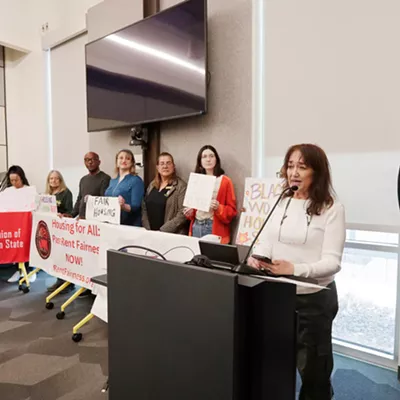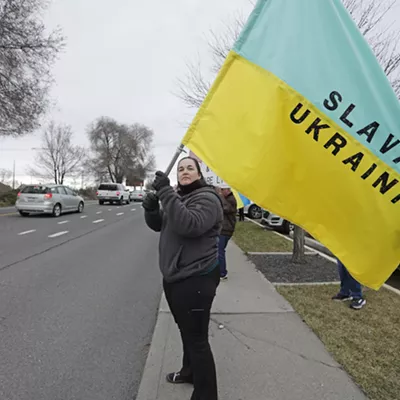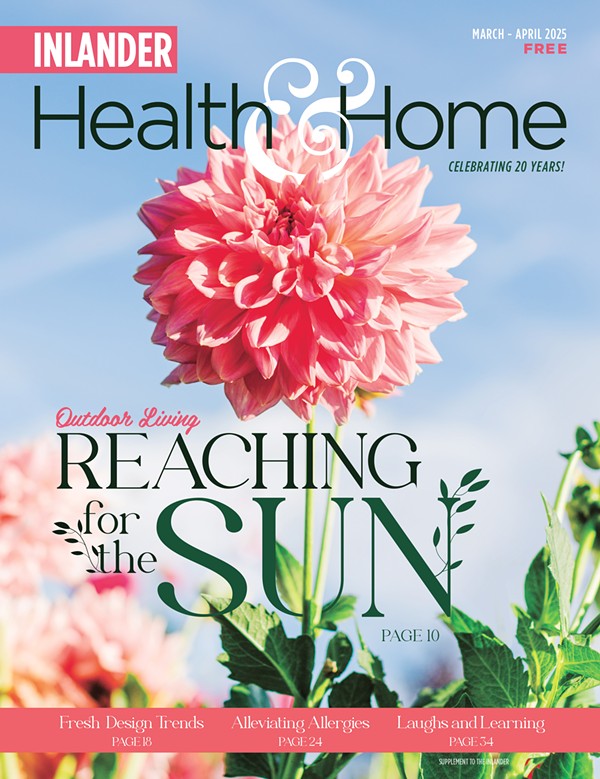When people ask me where I'm from, I point to the race tags over my door, bright paper numbers bearing the words BLOOMSDAY 12 KILOMETER RUN. I'm from Spokane. Seven and a half miles, 9 am, first Sunday in May: Be there, or be from Ellensburg -- or worse yet, be from Seattle. If you can't run Bloomsday, you'd better walk it. If you can't walk it, you'd better volunteer at a water station or a finish chute. If you can't volunteer, you'd better cheer. And if you can't do that, Dad, Mom, Nick, Mara and I say get out of town -- you're taking up good pavement.
It was all Don Kardong's doing. He ran a marathon in the 1976 Olympics, took fourth, then kept right on running across our Spokane TV screens. The man seemed tall, dark and sinewy to me as a child, just as I imagined my Ken doll looking if his plastic limbs were stretched an extra inch. Mom was a chemist with nice hair, and Dad smoked cigarettes on the back porch: Kardong was the first serious runner I'd ever seen.
Our North Side neighbor Linn Sampson turned out to be the second. He was one of the 1,200 who ran that first Bloomsday in 1977, and the reason my family started watching the race. We'd park our car as close as we could from the north end of the racecourse and walk -- blocks, because everyone who lived on the North Side has the same idea -- to the ledge above the Spokane River valley. Here, we spectators could see the runners cross the T.J. Meenach Bridge and trudge their way up Pettet Drive (quickly renamed "Doomsday Hill"), a river of moving legs and bobbing heads that stretched back more than a mile.
"Look for me near the left edge of the road," he'd tell us each year. "I'll be wearing a such-and-such-colored T-shirt." When we arrived at the designated spot, a sort of fruitlessness would sink in: People would be running past hundreds at a time and a large proportion would, inevitably, be wearing "a such-and-such colored" T-shirt. But Linn always found us, spirited despite the many miles he had come. "You're crazy!" we'd tell him over that bodily sea.
Nick and I would exchange wide-eyed glances as Linn disappeared. Doomsday Hill marks Bloomsday's fifth mile, and it was amazing to us (at ages three and five) that someone could run that far without looking tired. Our legs, stocky only with baby fat, ached just from standing there. But the runners after Linn were more real to us. After the yellow group came the slightly less fit green group, followed by an even slower blue group, followed by all the walkers in purple. As the tags on the runners darkened, the breathing got heavier, the crowds more dense. Soon hundreds of people were passing us at a time; women, old people, even -- and here I'd tug at Mom's nicely tucked-in shirt -- children my age.
"I think I see the last person," Nick would insist every three minutes or so. No matter how long my family stood there and watched, however, we never saw the end of that moving mass. Bloomsday registration jumped to 5,000 its second year, then quickly spiraled to more than 10,000.
It became a spectacle. From the outside in, you see people running so fast that their legs blur, people walking so slow that you know they'll be picked up by the "It's Been Five Hours and You're Not to the Finish Line, So We're Disqualifying You" truck. You see hard-eyed people running alone. You see groups as large as the streets are wide, the local ROTC group running in time and calling cadence:
Mile Five it's time to go
(Mile Five it's time to go)
The winner won an hour ago
(The winner won an hour ago).
You see people in costume, especially when the purple group walks by. A clown, a giant squirrel, a beer can. Check out the tap-dancing twins with star antenna headbands; come the walkers, the race stops being a race and becomes a parade.
Dad's first Bloomsday was in 1984. He was turning 40 that year and decided the race might be a fun way to get in shape. He'd jog for 20 minutes, then come back and smoke a cigarette. If Linn -- a lawyer -- could run seven miles, he figured, so could he. "I remember men older than me and kids younger than you and Nick passing me," Dad says. "But I was thrilled just to finish."
Memories of my first Bloomsday: Having my nose pressed into the backs of people's Ben-Gay smothered legs at the crowded starting line. The sound of the starting pistol shook my whole body. The candy bag Mom carried to bribe Nick and me forward ("Only five more miles to go, kids! Starburst?"). Smashing my cup at the water stop by the cemetery -- and not having to pick it up! Claiming my T-shirt: It was lilac-colored that year, with a stick-figure running across the chest.
Biggest memory: Eating pancakes in a sea of such shirts at the Village Inn with my family and the Sampsons, proud as pie. Nearly everyone in the restaurant had just come from the race, and I was in lilac, just like them.
One year Linn ran Bloomsday in a Superman T-shirt given to him as a gag gift. Another year, he ran it in 42 minutes -- just eight minutes slower than that year's winner. After his first Bloomsday, Dad became a serious runner, too. His "jogs" began taking him so far from our neighborhood that Mom would sometimes drive the car to pick him up or bring him water. One year he stopped smoking. The next, he ran Bloomsday in 52 minutes.
By the early '90s, more than 50,000 people were running Bloomsday each year. For race participants, this hoopla boiled town to one thing: lines at the Port-a-Potties were becoming ridiculously long.
I tried to remember to pee before I left for the race, but one year when I was in junior high, I forgot. I stopped at a cluster of outhouses just past mile two and impatiently waited my turn. By the time I got a toilet, I was so focused on reclaiming my goal of running the race under 90 minutes that I forgot to turn the "in use" knob from green to red. The next person in line, thinking the Port-a-Potty was vacant, swung the door open. And there I sat with my running shorts around my ankles while 50,000 people ran by!
As my limbs grew longer and my running shoes bigger, our family changed. Mara was born. Nick and I started high school. Mom got in shape. Dad got a new job -- and early-onset arthritis. No matter who we became or how our routines fluctuated, however, Bloomsday remained a constant, from the struggle to leave for the starting line on time, to our post-race brunch with the Sampsons.
Dad would wake us up at 6 am. Mom would yell at Dad for waking us up at 6 am. I'd fight with Dad over whether to eat breakfast. Mara, who would merely be a spectator and who thus had no right to demand immediate attention, would insist that I leave my freshly poured cereal to prepare her breakfast. Nick -- my Port-a-Potty experience foremost in his mind -- would demand the bathroom. One of us would not be able to find his race tag. One of us would not be able to find her running shoes. One of us -- and it wasn't Mom or Nick or me -- would say, "You guys just don't seem to get the correlation between getting a good starting place and getting a good time." Mom would tell Dad to cool it, then push sweatshirts and hats on us, oblivious to the rising sun and the warming day. Somehow, suddenly, we all felt ambivalent about the big race.
I even ran Bloomsday the year it fell after senior prom. I remember coming home at 4 am and Dad telling me in his kept-up-late-by-a-daughter-who-didn't-call-in anger that he was not going to allow me to run. But at 7 am, there I was in my running clothes, defiantly ready. I ran Bloomsday in 1:22 that year -- on two hours of sleep.
The first few miles were rough. My limbs weighed as much as my physics textbook, and my head felt as if it had been stuffed up the end of a marching-band tuba. But then I saw a homemade sign tacked on a tree beside the race course: MINDY SMITHPETER, WILL YOU MARRY ME? There was a Magic Marker hanging by a string in front of a hand-drawn set of YES and NO boxes. Remembering the good-night kiss of my date the night before, I got a sudden rush of energy. I laughed, sped up my legs and pushed on to the finish line. The next day, the morning paper showed Sandy Smithpeter running up to the sign in her Nike shorts and sports bra to check YES. Everyone around her was cheering.
At 13, Mara trains for the big race with the same vigor that she trains for her regional swim meets. With broad shoulders and muscular legs, she needs no Starbursts to push her to the finish line. "I ran Junior Bloomsday in '96," she recounts with pride. "My first real Bloomsday was in '97. I ran it with Mom and a friend."
In the fifth grade, Nick ran Bloomsday in 1:28: "I was in soccer that year, so I was stronger than I realized. I made it all the way to Doomsday Hill without having to walk."
He's still trying to beat that record -- hard to do when you're going to college 2,000 miles from home. "I've tried to find traditions here to make up for it," Nick says. "The Sidewalk Art Festival, spring trips to the coast. But Bloomsday is just so... Spokane."
I missed Bloomsday myself during the four years I was an undergraduate. Dad always sent me the official race poster to hang on my walls. "Race won't be the same without you," he'd write.
My first year back from college, I trained for Bloomsday like I'd never trained before, vowing I'd run the race in under an hour. I didn't make my goal, but my time that year - 1:06-- was enough to beat Dad, whose arthritis had slowed him considerably. For the first time in my life, I was the first member of my family over the finish line.
A funny thing happened after that Bloomsday: I kept running. Creating routes alongside the Spokane River, I could imagine how Don Kardong must have enjoyed designing the Bloomsday course from his everyday jaunts; I could imagine people calling me "crazy."
This May, for the first time in 18 years, Dad will not be running Bloomsday. He has just had a hip replacement in the hopes that he'll be able to get around a little better. "I took the official Bloomsday application to my physical therapist as a joke," he tells me. Dad laughs about it, but I know it will be hard for him to be the one that cheers people on from the sidelines.
Running the streets of my graduate school town, I wonder when I will be back in Spokane long enough to run the race again. I've never pictured living in Spokane permanently, but I can't imagine that my Bloomsday years are over. Perhaps I'll fly in with friends every now and then, a significant other, a family of my own, telling them as we step out into the May air, "This is where I'm from."
Kardong named Bloomsday after a day in the life of Leopold Bloom, the hero of James Joyce's Ulysses. In the epic novel, Bloom spends the day wandering through the streets of Dublin in a rough parallel to the hero of Homer's Odyssey, setting up a premise that Kardong has always embraced: that ordinary people are involved in unassuming yet heroic journeys every day of their lives. We've seen these people, too: folks who do Bloomsday on canes, in wheelchairs, while fighting cancer...
We are these people. Last year, while we were eating pancakes at the Village Inn with the Sampsons, an artist who had recently lost the use of one of her hands sketched my family on a napkin without our knowing it. We were all in our Bloomsday shirts: Dad with his sore hip, Mom with her nice hair, Mara with her inhaler, me on the cusp of leaving hometown for graduate school. Embarrassed about her condition, the artist had given the napkin to our server, with directions to give it to us after she had left. "Happy Bloomsday," she had written. "Thank you for your laughter. It made my day."
Dad dug out the napkin the other day and called me. "I go in for my big post-surgery checkup this week," he said. "If they take me off the crutches," he said, "I might. I just might..."
I picture my dad walking on the flat just before the cemetery. Whether he's hurting or not, he'll be smiling above his purple tag, for he knows there's no such thing as rest on the first Sunday in May, not really. Because here come 50,000 pairs of running shoes carrying 50,000 pairs of legs -- 50,000 citizens, blooming in the sun.
Elyse Fields is a Spokane native and Cheney High School graduate who has run in a dozen Bloomsdays since her first one in 1986. In 2004, she will earn an MFA in creative writing from the University of Iowa.
Publication date: 05/01/03
















